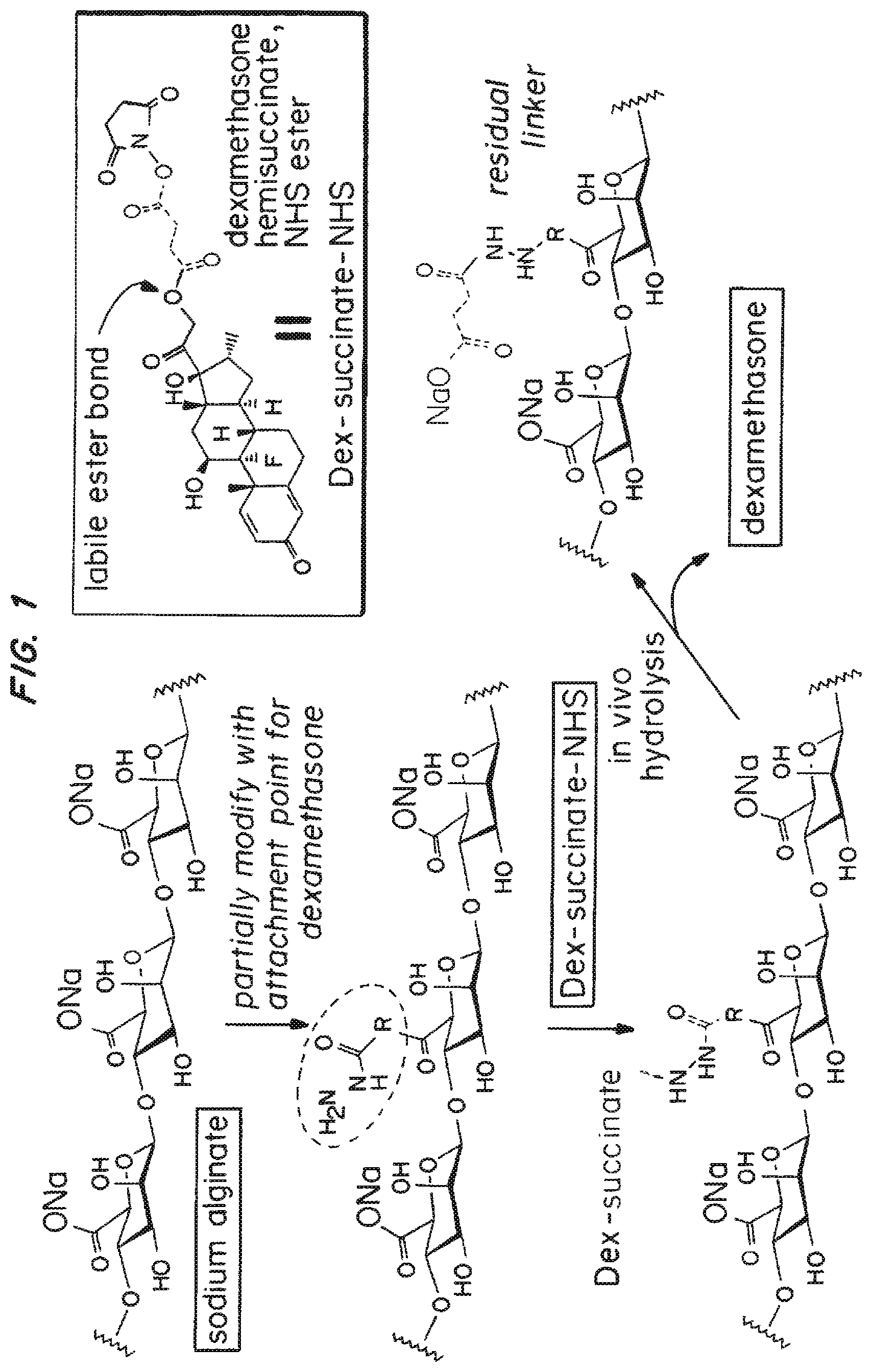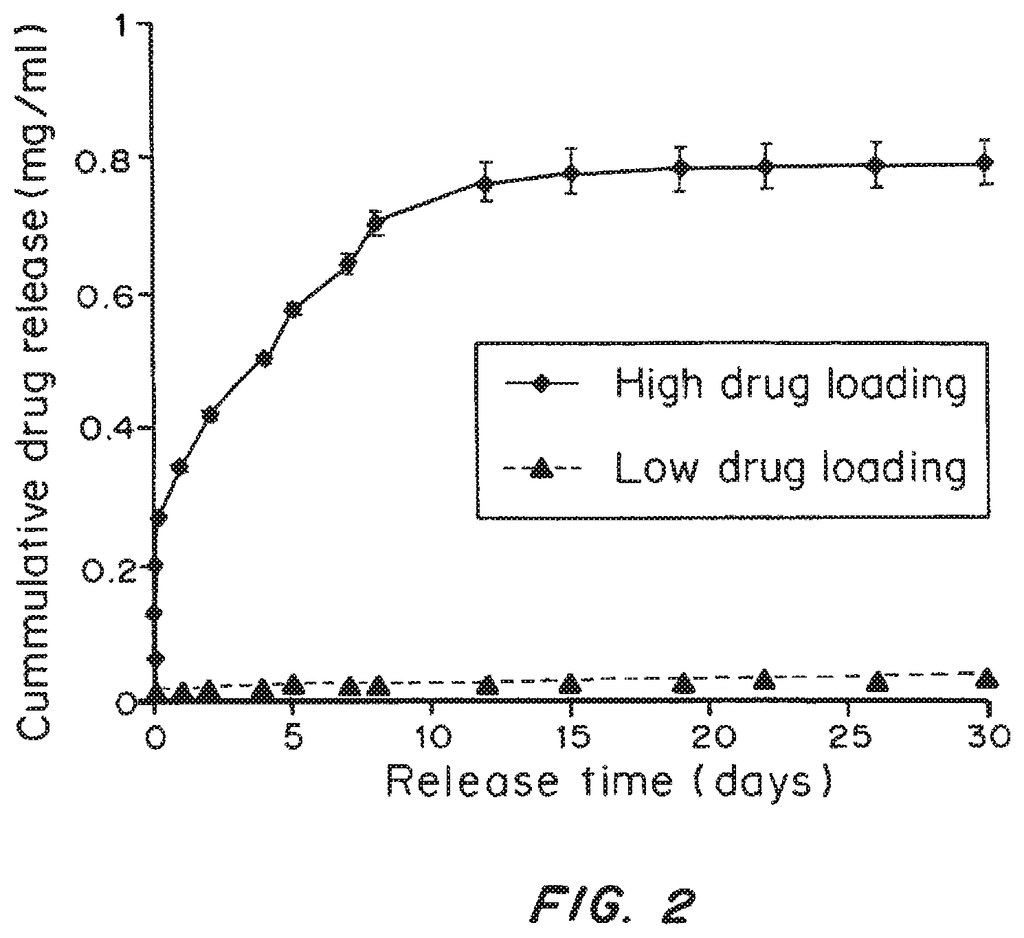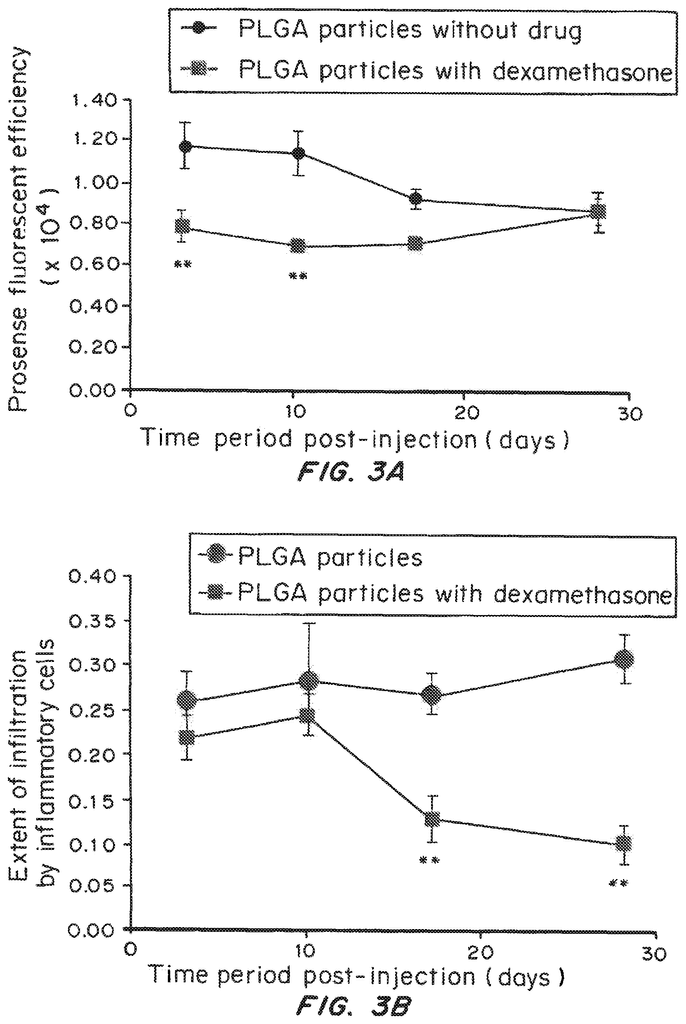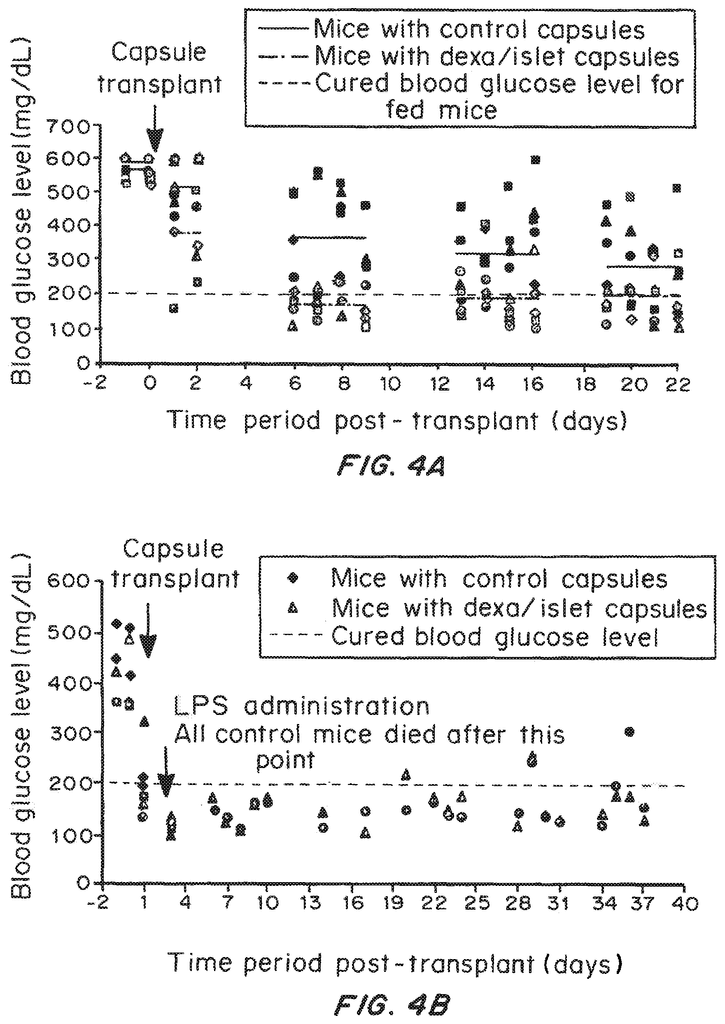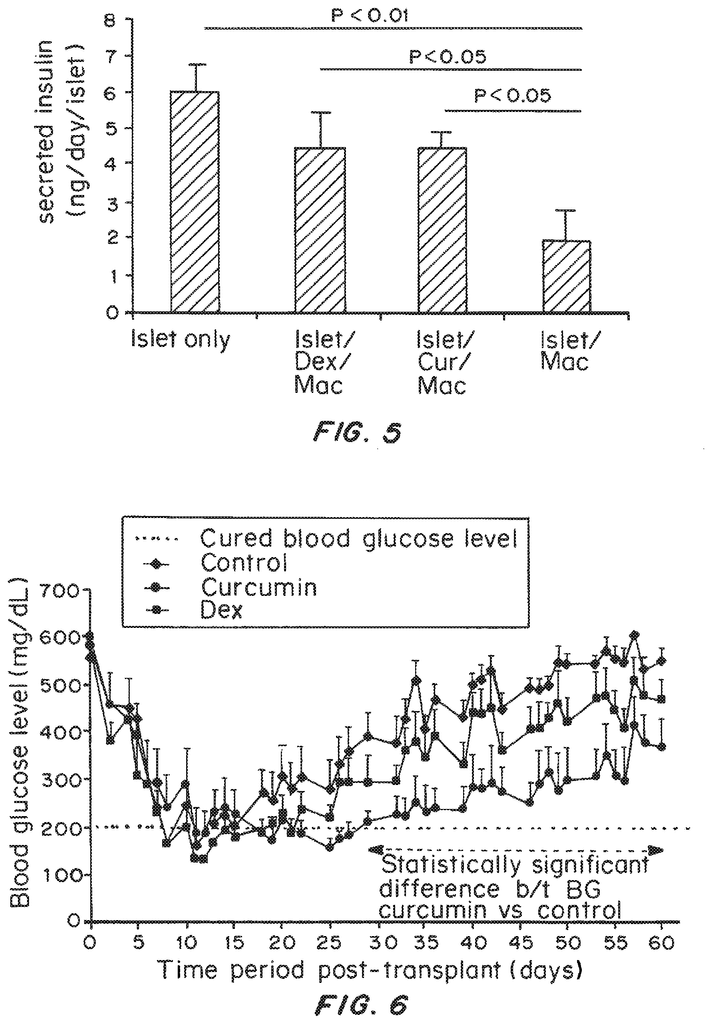Invented by Daniel G. Anderson, Robert S. Langer, Tram T. Dang, Childrens Medical Center Corp, Massachusetts Institute of Technology
Hydrogel-encapsulated cell therapy involves the use of hydrogel matrices to encapsulate living cells, such as stem cells or immune cells, for therapeutic purposes. These encapsulated cells can be implanted into the body to replace damaged or diseased tissues, promote tissue regeneration, or modulate the immune response. The hydrogel matrix provides a protective environment for the cells, allowing them to survive and function effectively.
The demand for hydrogel-encapsulated cell therapy is increasing due to its potential in treating a wide range of diseases, including cardiovascular disorders, neurological conditions, and orthopedic injuries. The ability of hydrogels to mimic the extracellular matrix and provide a suitable microenvironment for cell growth and differentiation makes them a promising tool in regenerative medicine.
In addition to cell therapy, hydrogels are also being used as carriers for anti-inflammatory drugs. Inflammation is a common underlying factor in many chronic diseases, including arthritis, inflammatory bowel disease, and asthma. Traditional drug delivery systems often fail to target the inflamed tissues effectively, leading to systemic side effects and reduced therapeutic efficacy.
Hydrogel-based drug delivery systems offer a solution to this problem by providing localized and sustained release of anti-inflammatory drugs. The hydrogel matrix can be designed to respond to specific stimuli, such as pH, temperature, or enzymes, allowing controlled release of the drug at the site of inflammation. This targeted delivery minimizes systemic exposure and maximizes the therapeutic effect, leading to improved patient outcomes.
The market for hydrogel-encapsulated cell and anti-inflammatory drugs is expected to witness substantial growth in the coming years. The increasing prevalence of chronic diseases, coupled with the growing demand for personalized medicine, is driving the adoption of these advanced drug delivery systems. Moreover, advancements in hydrogel technology, such as the development of bioactive and biodegradable hydrogels, are further fueling market growth.
However, there are certain challenges that need to be addressed for the widespread adoption of hydrogel-based therapies. These include the need for standardized manufacturing processes, regulatory considerations, and the high cost associated with the development and production of hydrogel-based products.
In conclusion, the market for hydrogel-encapsulated cell and anti-inflammatory drugs is poised for significant growth in the coming years. The ability of hydrogels to provide a suitable microenvironment for cell growth and deliver drugs in a targeted and controlled manner makes them a promising tool in regenerative medicine and personalized drug therapy. With ongoing research and technological advancements, hydrogel-based therapies have the potential to revolutionize the treatment of chronic diseases and improve patient outcomes.
The Childrens Medical Center Corp, Massachusetts Institute of Technology invention works as follows
A composition that contains biocompatible hydrogel and anti-inflammatory drugs encapsulating mammalian cell is disclosed.” After implantation, the encapsulated cell had reduced fibrotic growth. The compositions are composed of a biocompatible gel containing mammalian cell encapsulated with anti-inflammatory drug or polymeric particles infused with anti-inflammatory drug. After transplantation, the anti-inflammatory drug is released in a quantity that inhibits fibrosis for at least 10 days. The methods for selecting and identifying suitable anti-inflammatory drugs-loaded particles that prevent fibrosis are also described. “Methods for treating a condition in a patient are disclosed, which involve administering to the patient a therapeutically-effective amount of the disclosed encapsulated cell.
Background for Hydrogel-encapsulated cell and anti-inflammatory drugs
Transplantation can be used to provide diabetic patients with good glycemic management without the need for exogenous insulin.” The recipient must adhere to a lifelong immunosuppression regime, which can have serious side effects. The microencapsulation of human islets should prevent the rejection of the grafted tissues without the use anti-rejection medications.
However despite promising animal studies, encapsulated islets have yet to make an impact on the clinical setting. The successful application of a promising technology is hindered by many non-immunological factors and immunological ones, such as biocompatibility and reduced immunoprotection. Other issues include hypoxia, pericapsular overgrowth and fibrotic pericapsulum, the encapsulation procedure, and post-transplantation inflammation. Diabet Stud. 8(1):51 – 67 (2011 )).
Park H, et. al. Pharm Res 13(12):1770-6 (1996); Kvist P H, et al. Diabetes Technol 8(4):463-75 (2006); Wisniewski N, et al. J Anal Chem 366(6):611-21 (2000); Van der Giessen W J, et al. Circulation 94(7):1690-7 (1996); Granchi D, et al. J Biomed Mater Res 29(2):197-202 (1995); Ward C R, et al. Obstet Gynecol 86(5):848-50 (1995); Remes A, et al. Biomaterials 13(11):731-43 (1992)). This reaction is characterized by the recruitment of innate immune cells, such as macrophages and neutrophils, followed later by fibroblasts that deposit collagen, creating a fibrous cap around the implanted item (Williams, D. F. Biomaterials 29, 20:2941-53, (2008); Remes, A., et. al. Biomaterials 13(11):731-43 (1992); Anderson J M, et al. Semin Immunol 20(2):86-100 (2008); Anderson J M, et al. Adv Drug Deliver Rev 28(1):5-24 (1997); Abbas A K, et al. Pathologic Basis of disease. 7th ed. Philadelphia: W. B. Saunders (2009)). Fibrotic cells can interfere with electrical transmission (Singarayar 5 et al.). PACE 28(4) 311-5 (2005)). They can also prevent the transport of analytes. J Biomed Mater Res 37(3):401-12 (1997); Sharkawy A A, et al. J Biomed Mater Res 40(4):598-605 (1998); Sharkawy A A, et al. J Biomed Mater Res, 40(4), 586-597 (1998)). This can lead to a failure of implantable medical devices, such as immunoisolated islets for the pancreas (De Groot, et. al. J Surg Res 121(1):141-50 (2004); De Vos P, et al. Diabetologia 40(3):262-70 (1997); Van Schilfgaarde R, et al. J Mol Med. 77(1):199 – 205 (1999 )).
The incorporation of controlled release delivery systems of anti-inflammatory drug into medical devices was proposed as a way to reduce host response and increase device durability. (Wu P., et. al. Biomaterials 27(11):2450-67 (2006); Dash A K, et al. J Pharmacol Toxicol 40(1):1-12 (1998); Labhasetwar V, et al. J Appl Biomater 2(3):211-2 (1991); Morals J M, et al. AAPS J 12(2):188-96 (2010); Hunt J A, et al. J Mater Sci : Mater Med 3(3) : 160-9 (1992). This approach has been shown to be promising in several clinical applications. The controlled elution from pacemaker leads of steroid reduces the formation of fibrosis and improves long-term communication between leads and cardiac tissue surrounding them (Singarayar S et al. PACE 28(4) 311-5 (2005)). However, attempts to improve performance of other medical device such as immunoisolated insulin for diabetes treatment have proved challenging (Williams F. Biomaterials 28(20):2941-5 (2008 )).
Researchers developing controlled-release formulations for host response mitigation have focused largely on reducing the number of inflammation cells that infiltrate the interface between the device and the host. The design of controlled release formulations, such as drug selection and loading, particle size, and release kinetics, can affect the biological response in a variety of ways. Anti-inflammatory drugs can affect not only the number and type of immune cells recruited, but also their kinetics. This includes the secretion or signaling pathways of cell signaling enzymes. Inflamm Res 47(14):78-87 (1998); Rhen T, et al. New Engl J Med 353(16):1711-24 (2005)). In vivo, secretory products from cells may affect the rate of degradation of the polymeric matrix. (Erfle J D, et.al. Cardiovasc Pathol 6(6):333-40 (1997); Labow R S, et al. Biomaterials 16(1):51-9 (1995); Labow R S, et al. Biomaterials 23 (19):3969-75 (2002); Labow R S, et. al. J Control Release 127(2) 137-45 (2008 )).
There is a need to understand the immunomodulatory effect of anti-inflammatory drug on the host-tissue at the implant site” (Wu P. et al. Biomaterials 27(11):2450-67 (2006)). This knowledge could lead to improved design of controlled-release drugs delivery systems for implanted medical device biocompatibility.
The present invention aims to provide a system of cell encapsulation for transplanting stem cells with a reduced pericapsular overgrowth.
It is also an object of the invention, to provide a system that encapsulates cells and inhibits an immune response.
It is also an object of the invention that identifies anti-inflammatory drug formulations which inhibit inflammation caused by cells encapsulated.
It is also an object of this invention to improve methods for treating diabetes by using encapsulated insulin cells.
A biocompatible hydrogel that encapsulates mammalian cell and anti-inflammatory drug for transplantation, with reduced cellular immunity response and/or increased pericapsular fibrous overgrowth, has been developed. The hydrogel contains one or several mammalian cell encapsulations and one or multiple anti-inflammatory drugs that are dispersed, encapsulated, or encapsulated in a biocompatible gel. The anti-inflammatory drugs can be dispersed in the hydrogel to allow for rapid release or conjugated with the hydrogel using a biodegradable linker for delayed release.
In a preferred embodiment the anti-inflammatory drug or drugs are contained in polymeric particles that have been loaded with drugs for controlled release. In certain embodiments, cells and anti-inflammatory drugs (or drug-loaded polymeric particle) are encapsulated in the same biocompatible gel. In some embodiments, cells and anti-inflammatory drug or polymeric particle-loaded drugs are compartmentalized in the hydrogel. The drug can be compartmentalized on the hydrogel surface to facilitate outward diffusion of the drug, maximize drug interaction with the immune cells and minimize interference with mammalian cell inside. In preferred embodiments, the hydrogel composition comprises a core-envelope structure. In these embodiments the cells are preferably enclosed in a core-hydrogel, and the anti-inflammatory drug or polymeric particle-loaded with drugs are encapsulated inside an envelope-hydrogel. In some embodiments the envelope and core hydrogels may be separated by a shell or membrane.
Transplant rejection occurs as an adaptive immune reaction that is mediated both by cellular immunity, (mediated via killer T cells), and humoral immunity, (mediated through activated B-cells secreting antibodies molecules), as well as an innate response mediated by the phagocytic cell and soluble immune protein. Cellular immunity protects your body by activating antigen specific cytotoxic lymphocytes, which are able induce apoptosis on body cells that display epitopes of antigens on their surfaces, activating natural killer cells and macrophages, and stimulating the cells to secrete various cytokines, that influence other cells that are involved in adaptive and innate immune response. In preferred embodiments the anti-inflammatory drug is released in a quantity that inhibits cellular immunity for at least two weeks at the site of the transplant.
In some embodiments, one or more antiinflammatory drugs are released in a composition at a rate that provides spatially localized inflammation inhibition in the subject for ten days or longer, preferably 14 days, 30 days, 60 days or 90 days. In some embodiments the localized inflammation is inhibited without systemic immune suppression. In certain embodiments, the cathepsin level at the injection site in the subject is measured to detect spatially localized inflammatory changes. In some embodiments, the measurement of reactive oxygen species (ROS), at the injection site in the subject, is used to detect spatially localized inflammatory conditions. In certain embodiments, systemic immunesuppression can be detected by measuring the absence of cathepsin or ROS in control sites, such as sites injected with drug free polymeric particles or hydrogel.
In some cases, one or more antiinflammatory drugs inhibit the pericapsular fibrous fibrosis after administration of the composition into the subject, by at least 50%. More preferably, 60%, 70%, 88%, 90% or 100% for at least 10 or 14 days. In preferred embodiments the anti-inflammatory drug is released in a quantity that prevents detectable fibrosis for at least 30 or 60 days.
The hydrogels are available in any size and shape that is suitable for cell encapsulation or transplantation. In preferred embodiments, hydrogels can be formed into microcapsules. The microcapsules used to encapsulate cells have a preferred diameter between 150 m and about 1000 m.
In some embodiments, compositions are made into macrodevices. In some embodiments, for example, hydrogel-encapsulated cells are coated on a surface such as a plane surface. In certain embodiments, cells encapsulated in microcapsules are adhered to the tissue of a patient using a biocompatible glue. In some embodiments, the microcapsules are coated on a medical implantable device. In these embodiments the anti-inflammatory drugs or drug-loaded particle may be encapsulated in the hydrogel with the cells. In preferred embodiments the anti-inflammatory drugs or drug-loaded particle are incorporated in the biocompatible adhesive. FIG. FIG.11C shows a macrodevice. This figure shows that microcapsules are able to be molded in desired shapes and geometry, for example, suitable for engineering 3D tissues constructs and macrodevices. Biomaterials 30:6896-6902 (2009)).
The compositions can be made into artificial organs such as a pancreas artificial containing islet cells encapsulated. In some embodiments, cells are encapsulated within a single compartment of hydrogel. In other embodiments the composition comprises a plurality microencapsulated cell dispersed or enclosed in a biocompatible matrix.
In some embodiments the anti-inflammatory drug is present as a free drug in the compositions. In some embodiments, anti-inflammatory drug is present in polymeric particles that are drug-loaded. Preferably, the drug-loaded polymeric particles will be microparticles and nanoparticles. The particle’s mean diameter can be optimized and selected based on drug type, dosage and release rate. In preferred embodiments the drug-loaded polymeric particles have a mean size of 1 m to 100 m, preferably 1 m to 50 mm, and more preferably 1 mm to 10 mm. Other embodiments include drug-loaded polymeric nanoparticles with a diameter ranging from 10 nm up to about 999nm. Preferably, the particles have a minimum of 50 nm and preferably preferably a minimum of 100 nm.
Biocompatible hydrogels suitable for cell encapsulation include polysaccharides and polyphosphazenes. They also include copolymers of methacrylic and acrylic acids, copolymers of poly(alkylene oxides), and poly(vinylacetate). The biocompatible hydrogel in preferred embodiments is a polysaccharide. Alginate, Chitosan, Hyaluronan, and Chondroitin Sulfate are preferred polysaccharides. Alginate is a preferred hydrogel to encapsulate cells.
Biocompatible, biodegradable polymers suitable for controlled drug delivery are also known in the art and include polylactic acid (PLA), polyglycolic acid (PGA), poly(lactic-co-glycolic acid) (PLGA), polycaprolactone (PCL), polyhydroxyalkanoate (PHA), poly(lactic acid)-poly(ethylene oxide) (PLA-PEG), polyanhydrides, poly(ester anhydrides), polymethylmethacrylate [PMMA], poly(2-hydroxyethyl methacrylate) [pHEMA], polycaprolactone [PCL], cellulose acetate, chitosan, and copolymers and blends thereof. A particularly preferred polymer for controlled delivery of anti-inflammatory drugs from hydrogels is poly(lactic-co-glycolic acid) (PLGA).
Click here to view the patent on Google Patents.
